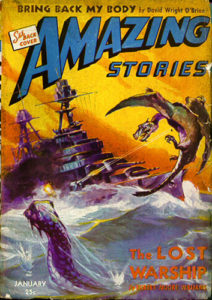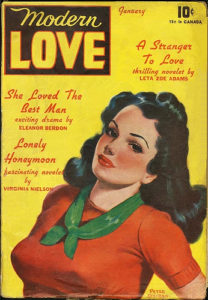The Pulp Legacy: Modern Pulp Fiction
Posted by Rampant Coyote on July 1, 2016
 My previous post was all about classic “pulp” fiction from the late 19th century up through the middle of the 20th century. But then… it died out. Maybe not as dead as disco, but that particular form faded into the background. The rise of easier, more accessible entertainment probably accounted for much of it.
My previous post was all about classic “pulp” fiction from the late 19th century up through the middle of the 20th century. But then… it died out. Maybe not as dead as disco, but that particular form faded into the background. The rise of easier, more accessible entertainment probably accounted for much of it.
However, in spite of the decline, there are still a lot of folks out there who prefer reading as a primary or a secondary source of entertainment.
Even as the market for genre short fiction contracted, novels grew in popularity (and in the 1980s, seemed to grow significantly in page count and word count as well, compared to the slender pulpy novels that were popular up through the 1970s). The more constricted market made it more difficult for new writers, but the old pulp pros kept writing their stories and doing their thing. The distribution and preferences may have shifted, but the pulp story never really went away.
Stories Galore and on the Cheap
While Analog Magazine (AKA “Analog Science Fiction and Fact”) is now a “pro” magazine (paying higher-tier rates for genre fiction), it had its origins as a pulp magazine, going under the title “Astounding Stories,” and has been going on since 1930. That makes it pretty solidly the longest continuously-published science fiction magazine. Sadly, when adjusted for inflation, those “pro rates” seem to be about what the pulps paid back in the day. Or less. But that’s the short story market today.
 It’s not alone. In the “pro market” for science fiction and fantasy – some of the top shorter-form fiction published today on a regular basis, you’ve got Asimov’s, Intergalactic Medicine Show, Clarkesworld, Galaxy’s Edge, Apex, Daily Science Fiction, Fantastic Stories of the Imagination, and many others. These have some of the best genre stories out today (at least according to the tastes of the editors and the style preferences of the magazine), but even that represents a small fraction of the short form speculative fiction stories coming out today. At the “semi-pro” level, the list gets even bigger and more interesting (and specialized), with more genres represented. And there are entire sites (like Daily Science Fiction) that really specialize in flash or very-short stories. Moving out to anthologies of new fiction (which may be one-off, irregularly published, or only published annually or whatever), things get even more exciting. (I recommend Writers of the Future, an annual anthology of some of the best up-and-coming new authors and artists).
It’s not alone. In the “pro market” for science fiction and fantasy – some of the top shorter-form fiction published today on a regular basis, you’ve got Asimov’s, Intergalactic Medicine Show, Clarkesworld, Galaxy’s Edge, Apex, Daily Science Fiction, Fantastic Stories of the Imagination, and many others. These have some of the best genre stories out today (at least according to the tastes of the editors and the style preferences of the magazine), but even that represents a small fraction of the short form speculative fiction stories coming out today. At the “semi-pro” level, the list gets even bigger and more interesting (and specialized), with more genres represented. And there are entire sites (like Daily Science Fiction) that really specialize in flash or very-short stories. Moving out to anthologies of new fiction (which may be one-off, irregularly published, or only published annually or whatever), things get even more exciting. (I recommend Writers of the Future, an annual anthology of some of the best up-and-coming new authors and artists).
And that’s just short-form fiction. I’m not even going to go into novels, or the explosion of small and indie press publishers. Clearly, there’s plenty for a reader to choose from. Too much, probably. The biggest challenge is for readers to find ones that cater to their interests.
With the advent of digital publishing, print-on-demand, and similar technologies, the cost of distribution is cheaper than the pulp publishers could have dreamed. Because of the ease of self-publishing, this has sadly lowered the bar a bit in terms of overall quality. No gatekeepers means there are no filters. Just like the indie video game industry, I prefer a world with no gatekeepers than one where said gatekeepers have great control over what trickles out to the marketplace. Fortunately, just like they heyday of the pulps, there may be a lot of crap out there, but there are lots of good and great stories as well, of all sizes: From tome-sized novels down to “flash fiction” of less than 1,000 words (often 500 or less).
Really, the digital revolution makes the pulp era kinda pale by comparison.
“New Pulp” – Same Great Taste, Fewer Calories.
There are lots of anthologies that have sought to emulate the pulp style and flavor – even to the point of setting the stories in the era of pulp’s dominance. Hard-boiled detective novels set in the 1930s. Or – one of my favorite ideas – “Dieselpunk” stories set in an alternate history version of the early-to-mid 20th century. In some cases, its simply to revive a subgenre that has been left somewhat fallow over the decades.
 Ultimately, I don’t see a need for any kind of pulp “revival” because I don’t believe it never went away. It evolved and changed a bit with the times and technology, but not as much as some folks might imagine. It learned how to better meet the tastes of its audience. It learned the tricks and tips to tell a better story. The pulp era was a survival-of-the-fittest test of stories and storytellers, but the lessons they learned were shared and spread.
Ultimately, I don’t see a need for any kind of pulp “revival” because I don’t believe it never went away. It evolved and changed a bit with the times and technology, but not as much as some folks might imagine. It learned how to better meet the tastes of its audience. It learned the tricks and tips to tell a better story. The pulp era was a survival-of-the-fittest test of stories and storytellers, but the lessons they learned were shared and spread.
Because pulp covered such a wide range of styles and genres, it’s pretty difficult to nail down exactly what made a “pulp” story then, or its successors today. It was more of an approach and an intended audience. These were the stories for the common man (and woman). While they might have had big ideas, thought-provoking situations, deeper meanings, themes, and messages, their primary focus was to entertain. These weren’t stories to win awards, these were stories to be worth a working person’s hard-earned change for several hours of escape. Considering pulp’s peak included wartime and the Great Depression, escape was often desperately needed.
Today isn’t that different. The reading audience of today may be more discerning, demands higher quality writing (modern tools make this easier), and demands more detailed characters. But those of us who read for entertainment still like the same things. Lester Dent’s “Master Plot Formula” and a dozen variants for different genres and types of stories that were learned the hard way during the golden age of pulp don’t need many changes to be perfectly valid today. A lot of the best-selling authors today go straight from the pulp playbook. Some even admit it.
While authors might not be able to make a living cranking out short fiction anymore, and the newsstands don’t blossom with dozens of lurid covers of cheap fiction magazines these days, pulp fiction is still with us. It’s fast-moving, fun, simple, layered, and punches its way through the story with visceral details. It entertains, first and foremost. It may also creep out, titillate, inspire, explain, conjecture, evangelize, provoke, or encourage. But it’s not really out to show off… it’s there to give the reader a good time.
Pulp didn’t pay much, but it did pay, and the market was large enough to support a prolific writer of reasonable skill. The point for pro writers in the pulp era was to write fast with as few revisions as possible. Make it good, make it fast, make it stand out. Sell lots. That’s still great advice.
I’ve heard arguments against this, that a good writer should agonize and labor over every word. While I’m definitely no expert, I personally don’t see how writing should be different from every other skill in the world, where lots of practice yields improved results. Lacking a depth of personal expertise, I’ll just quote the godfather of hard-boiled detective genre, Raymond Chandler: “The faster I write, the better my output. If I’m going slow, I’m in trouble. It means I’m pushing the words instead of being pulled by them.”
James Patterson and Nora Roberts have story structures that fit very easily into Lester Dent’s formula. Michael Crichton may not have been the greatest wordsmith in the world, but his novels were full-on pulp adventures and frequently turned into movies, including a blockbuster franchise.
 At one conference, the romance novelist L. L. Muir (her pen name) pulled out Michael Moorcock’s pulp novel writing formula and showed us how she adopted it to cranking out the first draft of a romance novel in three days. At another conference, J. Scott Savage (author of a number of middle-grade fantasies) shared a not-so-secret formula for successful pacing, using several popular movies and books to show how they fit perfectly within this structure. And … color me not surprised… it was key parts of the Lester Dent formula. Since I’ve learned more of how successful pulp stories were structured and the techniques they evolved to crank out popular fiction, I’ve seen it over and over again in novels by my favorite authors. While it makes them a little more predictable, I can’t say that knowing how the sausage is made has really detracted from the experience.
At one conference, the romance novelist L. L. Muir (her pen name) pulled out Michael Moorcock’s pulp novel writing formula and showed us how she adopted it to cranking out the first draft of a romance novel in three days. At another conference, J. Scott Savage (author of a number of middle-grade fantasies) shared a not-so-secret formula for successful pacing, using several popular movies and books to show how they fit perfectly within this structure. And … color me not surprised… it was key parts of the Lester Dent formula. Since I’ve learned more of how successful pulp stories were structured and the techniques they evolved to crank out popular fiction, I’ve seen it over and over again in novels by my favorite authors. While it makes them a little more predictable, I can’t say that knowing how the sausage is made has really detracted from the experience.
Dean Wesley Smith is unapologetic about his use of the Lester Dent pulp “formula.” He states, “All bestsellers in modern times follow this structure as well, which is why they sell so many copies.”
The cheap pulp paper has given way to eBooks and print-on-demand. Reading for entertainment is more of a preference now among many cheap, easy alternatives than existed nearly a century ago. The market has changed. Styles and genres have shifted around. But the fundamentals are the same. What makes a good story now hasn’t changed much, although we probably understand it better now than in 1930. And the need for great, entertaining fiction is as strong today as ever.
Filed Under: Books, Writing - Comments: Comments are off for this article
